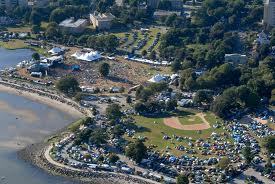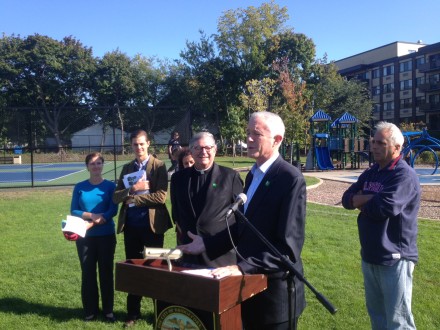
A report by an environmental economics class at Fairfield University validates city parks as an economic driver concluding that residential and commercial properties located within one tenth of a mile from a park in Bridgeport have, on average, an 8 percent and 11 percent higher property value respectively than properties located within the next tenth from a park. See study here.
“The Valuation of Bridgeport Parks” is a collaborative between the City of Bridgeport and Fairfield University. The study was initially researched by students from Professor Dina Franceschi’s Environmental Economics Class last year.

Some information for the study was pulled from research conducted for parks in New York City where famed Central Park architect Frederick Law Olmsted conducted a study about the connection between a new park and area property values to justify the investment for the park’s construction. Olmsted designed Seaside Park from property donated by P.T. Barnum. It helped to foster the city’s nickname The Park City.
Monday afternoon (today), Mayor Bill Finch will join Fairfield University President Jeffrey P. Von Arx at Ellsworth Park in Black Rock to announce key findings from the study such as:
· Residential properties located within one tenth of a mile from a park in Bridgeport have, on average, an 8 percent higher property value than residential properties located within the next tenth from a park. Commercial properties show an even greater gain in property value within the first tenth of a mile from a park, showing an 11 percent increase compared to properties in the second tenth of a mile from a park.
· 9.3 acres of green, open parkland for every 1000 Bridgeport residents, totaling up to 1356 acres of parks. And, 88 percent of residents live within a 10 minute walk to one of Bridgeport’s 46 parks. Bridgeport’s parks facilities offer a multitude of recreational activities leading to health benefits and less medical costs.
· Enhancement of citywide volunteerism. According to estimates made by the Park City Schools and Community Alliance, approximately 386,375 hours of documented community service in the Bridgeport City Park System took place between the beginning of April 2012 and the end of May 2014.
· Providing benefits for water filtration and re-use. If we woke up tomorrow, and someone had developed all of Bridgeport’s parkland, this would add 729,900,000 gallons of water to the volume that the WPCA already treats per year, and Bridgeport taxpayers would collectively pay $751,289 more in water treatment related taxes every year.
The study concludes:
Investments in parks contribute back to the community in a number of ways that are not easily quantifiable in financial terms. There are many other areas that show how parks benefit society that we have not quantified in this study. For example, the social well-being benefits that park venues provide for social interaction, the role they play in neighborhood security and crime reduction, educational benefits provided to young students for learning, and the increased tourism that occurs because of these destinations. These dynamic non-market forces play a significant role in how we spend our resources towards parks.
“In Bridgeport, we’re focused on making our city a place where companies want to invest and hire people, and a place where even more people choose to live, work, and raise their families,” said Mayor Finch in a statement. “Parks play a key role in doing just that. By re-opening Pleasure Beach this summer, building a new Knowlton Park, and continuing to enhance places like Seaside Park, we’re improving the quality of life for our residents while increasing property values in our neighborhoods. That’s why this study is so important, and shows that the city is doing right by residents, and building toward a more prosperous future.”
“Fairfield University is proud to have worked in partnership with the City of Bridgeport on this significant project,” said Fairfield University President Von Arx. “We are delighted that our Professor Dina Franceshi and her Environmental Impact Class were able to participate in a study that supported the viability and the economic good-sense of preserving parkland for the city. Fairfield University is part of the fabric of the Bridgeport community. Nearly 100 of our faculty and staff live and raise their families in Bridgeport, and there are over 1100 Fairfield graduates who hail from Bridgeport. In every important respect the health and vibrancy of the city of Bridgeport and the health and vibrancy of Fairfield University go hand in hand–so we are always looking for an opportunity to deepen and strengthen our relationship.”


“… and continuing to enhance places like Seaside Park, we’re improving the quality of life for our residents while increasing property values in our neighborhoods.” Is that what the Mayor calls allowing UI to install a 9000-panel solar array at/adjacent to Seaside? I call it extremely shortsighted.
Desecrating Seaside Park, decimating Black Rock property values, partnering with a university that isn’t even in the city of Bridgeport to study it, then calling a press conference to brag about it says it all about Bill Finch. What a bone-headed jerk.
Well with this jerk as mayor and 19 idiots on the council, we will be lucky if we have any parks left now that they know there is money there. Look how fast they sold out to the UI.
Nice for students and mayor to promote the parks.
It might be fun to look at the raw data and how it was processed.
For instance, have the changes around Knowlton Park or the Annex Park increased values with 1.7 football fields of them?
Mind you I am not knocking parks at all. And I love trees. They are easy on the eye and once planted in a good location repay your investment for many years with their environmental role.
Even if the location of a park provides an 8% bump to park neighbors, what has sent appraisal values down 50% or more in parts of the City, and what does the City have to say about it? Especially when some foreclosures are precipitated by WPCA liens, interest, legal expenses, etc. It’s a dark place and pretty merciless I am told for anyone who has had to deal with this “City Machine.” Why? Why not just go sit in a park, take some fresh breaths and figure a way to get to win-win? Time will tell.